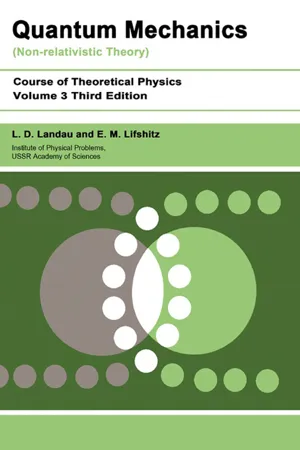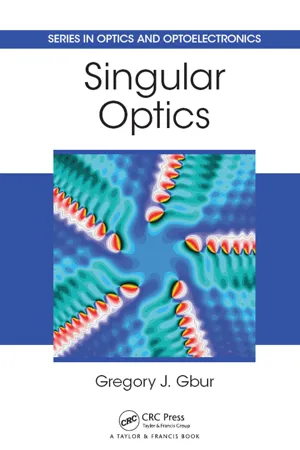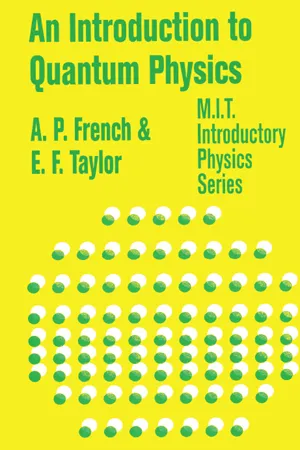Physics
Angular Momentum Coupling
Angular momentum coupling is a phenomenon in which the total angular momentum of a system is conserved by the coupling of individual angular momenta. This coupling occurs when two or more particles interact with each other, and their angular momenta combine to form a new, total angular momentum. The resulting angular momentum can be used to describe the motion of the system as a whole.
Written by Perlego with AI-assistance
Related key terms
Related key terms
1 of 4
Related key terms
1 of 3
4 Key excerpts on "Angular Momentum Coupling"
- eBook - ePub
- Mark Julian Everitt, Kieran Niels Bjergstrom, Stephen Neil Alexander Duffus(Authors)
- 2023(Publication Date)
- Wiley(Publisher)
If you have any experience with chemistry, you will likely have already drawn the correct conclusion that these states are closely related to atomic orbitals – a subject we will later return to. 5.4 Addition of Angular Momentum 5.4.1 The General Theory In classical mechanics, the total angul ar momentum of a system of particles is the sum of the angular momenta of each particle. For a system of particles the total angular momentum may be an integral of the motion but the individual angular momenta are not. We now consider the quantum case of the angular momentum of a system of ‘particles’ (by particle we mean a subsystem for which an angular momentum can be defined). The spaces of each particle are denoted in parentheses, so that is the component of angular momentum in the second space and is the square of the angular momentum in the fourth space. To reduce the burden of notation, we will use the same symbol for the operator within each space and its extension to the full tensor product space. The commutation relation of each component of angular momentum is given by (5.76) Here, is the Levi–Civita antisymmetric symbol that describes the permutations of and denotes the commutation of operators in different subspaces. We will make use of a shorthand for the state (5.77) The operators can be used to form a CSCO. This is very useful for some problems (especially a set of two-level systems, where this would be a CSCO. For qubits (quantum bits) this is the computational basis and it is also a standard choice for studying spin chains. The actions of and on the ket is, as before, given by: (5.78) Just as with classical mechanics there are a number of systems where the total angular momentum may commute with the system Hamiltonian, but the do not. For those systems, an alternative basis is of greater utility - eBook - ePub
Quantum Mechanics
Non-Relativistic Theory
- L D Landau, E.M. Lifshitz(Authors)
- 1981(Publication Date)
- Butterworth-Heinemann(Publisher)
L while remaining unchanged in magnitude.For such systems the question arises regarding the “law of addition” of angular momenta: what are the possible values of L for given values of L 1 and L 2 ? The law of addition for the components of angular momentum is evident: since , it follows that(31.1)There is no such simple relation for the operators of the squared angular momenta, however, and to derive their “law of addition” we reason as follows.If we take the quantities L 1 2 , L 2 2 , L1z, L2zas a complete set of physical quantities,† every state will be determined by the values of the numbers L 1 , L 2 , M 1 , M 2 . For given L 1 and L 2 , the numbers M 1 and M 2 take (2L 1 +1) and (2L 2 + 1) different values respectively, so that there are altogether (2L 1 + 1) (2L 2 +1) different states with the same L 1 and L 2 . We denote the wave functions of the states for this representation by .Instead of the above four quantities, we can take the four quantities L1 2 , L2 2 , L2 , L Z as a complete set. Then every state is characterized by the values of the numbers L 1 , L 2 , L , M (we denote the corresponding wave functions by ). For given L 1 and L 2 , there must of course be (2L 1 + 1)(2L 2 + 1) different states as before, i.e. for given L 1 and L 2 the pair of numbers L and M must take (2L 1 + 1)(2L 2 - eBook - ePub
- Gregory J. Gbur(Author)
- 2016(Publication Date)
- CRC Press(Publisher)
tot within a closed volume must involve a flow of electromagnetic angular momentum through the surface. We may introduce a new tensorM (r ′, t ) ≡r ′× T (r ′, t ) ,(5.28) which we refer to as the angular momentum flux density of the field, and we have already introduced the angular momentum density in Equation 5.22 .It should be noted that we are defining the torque with respect to an origin specified by the position vector r′. Our resulting definition of electromagnetic angular momentum is therefore dependent on the choice of coordinate system. This is not necessarily a problem when looking at the interaction of light and matter: by choosing the origin, we are implicitly choosing the mechanical axis of rotation. However, we run into difficulties when we consider the angular momentum of the field in isolation: is there a unique definition of the angular momentum of an electromagnetic wave that does not depend on the choice of coordinates? This will be discussed in Section 5.4 .In studying the angular momentum of light, it is tempting to focus on the angular momentum density l5.2 ORBITAL AND SPIN ANGULAR MOMENTUMfield, a vector quantity, rather than the much more complicated tensor quantity M. However, in quantifying the optical forces induced in matter, we will be more interested in the flux of angular momentum in beams, which makes M the more natural choice for our study. This is explained in more detail by Barnett [Bar02]. In short, the angular momentum density tells us where the angular momentum is located in a light wave, but the angular momentum flux tells us how that angular momentum is transferred across a closed boundary and therefore into matter.We have already mentioned that the angular momentum of light can often be decoupled into a spin part (associated with circular polarization) and an orbital part (associated with vortex phase). This decomposition is akin to the separation of Earth’s motion in the solar system into a spin part (Earth’s daily rotation about its own axis) and an orbital part (Earth’s yearly orbit around the Sun). Building on the results of the previous section, we now demonstrate this decoupling. - eBook - ePub
- A.P. French(Author)
- 2018(Publication Date)
- Routledge(Publisher)
l has a corresponding z component of magnetic moment given byμ z= −m lμ B( orbital )(11-24) (The minus sign comes from the fact that the electron charge is negative.) But for the z. component of magnetic moment due to spin, we have11μ z= −g sm sμ B( spin )(11-25) where the “g factor” g11-5 SPIN-ORBIT COUPLING ENERGYsis very close to 2.As we have discussed in the previous section, the splitting of a cesium beam into two components by a transverse magnetic field gradient (Section 10-3 ) tells us that the total angular momentum of a cesium atom in the ground state is that of its valence electron, with spin i and zero orbital angular momentum. The orbital and spin angular momenta of all the other electrons (an even number) pair off and so their magnetic moments cancel.When orbital angular momentum and spin angular momentum both exist in the same atom, the magnetic moments that result from these two angular momenta interact to cause a splitting in the corresponding energy level. Roughly speaking, the energy of the system is slightly higher when the orbital and spin magnetic moments are “parallel” than when they are “antiparallel.” Since the interaction that leads to this energy difference is between the spin and the orbital electronic structure, this interaction is called spin-orbit coupling or L-S coupling.A simple semiclassical calculation of the order of magnitude of the energy of the spin-orbit coupling for a single electron can be made using the Bohr model. Suppose, to be specific, that an electron is orbiting a proton with one unit of angular momentum. (Recall that in the Bohr theory this is the smallest possible orbital angular momentum.) We then haveM eυ r = ℏNow, if we imagine ourselves sitting on the electron, we see the proton describing an orbit of radius r with speed v. This represents a circulating current I equal to ev/2πr
Index pages curate the most relevant extracts from our library of academic textbooks. They’ve been created using an in-house natural language model (NLM), each adding context and meaning to key research topics.
Explore more topic indexes
Explore more topic indexes
1 of 6
Explore more topic indexes
1 of 4



